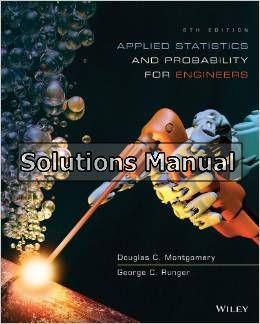
CHAPTER 2
Section 2-1
ProvideareasonabledescriptionofthesamplespaceforeachoftherandomexperimentsinExercises2-1to2-17. Therecanbemorethanoneacceptableinterpretationofeachexperiment.Describeanyassumptionsyoumake.
2-1. Eachofthreemachinedpartsisclassifiedaseitheraboveorbelowthetargetspecificationforthepart. Let a and b denote a part above and below the specification, respectively.
2-2. Eachoffourtransmittedbitsisclassifiedaseitherinerrorornotinerror.
Let e and o denote a bit in error and not in error (o denotes okay), respectively.
2-3. Inthefinalinspectionofelectronicpowersupplies,eitherunitspass,orthreetypesofnonconformitiesmight occur:functional,minor,orcosmetic.Threeunitsareinspected.
Let a denote an acceptable power supply.
Let f, m, and c denote a power supply that has a functional, minor, or cosmetic error, respectively.
2-4. Thenumberofhits(views)isrecordedatahigh-volumeWebsiteinaday.
= set of nonnegative integers
2-5. Eachof24Websitesisclassifiedascontainingornotcontainingbannerads.
Let y and n denote a web site that contains and does not contain banner ads The sample space is the set of all possible sequences of y and n of length 24. An example outcome in the sample space is yynnynyyynnynynnnnyynnyy S
2-6. Anammeterthatdisplaysthreedigitsisusedtomeasurecurrentinmilliamperes.
A vector with three components can describe the three digits of the ammeter. Each digit can be 0,1,2,...,9. The sample space S is 1000 possible three digit integers, 000,001,...,999 S
2-7. Ascalethatdisplaystwodecimalplacesisusedtomeasurematerialfeedsinachemicalplantintons.
S is the sample space of 100 possible two digit integers.
2-8. Thefollowingtwoquestionsappearonanemployeesurveyquestionnaire.Eachanswerischosenfromthefive point scale1(never),2,3,4,5(always).
Isthecorporationwillingtolistentoandfairlyevaluatenewideas?
Howoftenaremycoworkersimportantinmyoveralljobperformance?
Let an ordered pair of numbers, such as 43 denote the response on the first and second question. Then, S consists of the 25 ordered pairs 1112 55 , , ,
2-9. Theconcentrationofozonetothenearestpartperbillion.
09 0,1,2,...,1E S in ppb.
2-10. Thetimeuntilaservicetransactionisrequestedofacomputertothenearestmillisecond.
0,1,2,...,
S in milliseconds
2-11. ThepHreadingofawatersampletothenearesttenthofaunit.
2-12. Thevoidsinaferriteslabareclassifiedassmall,medium,orlarge.Thenumberofvoidsineachcategoryis measuredbyanopticalinspectionofasample.
Let s, m, and l denote small, medium, and large, respectively. Then S = {s, m, l, ss, sm, sl, ….}
2-13 Thetimeofachemicalreactionisrecordedtothenearestmillisecond.
0,1,2,...,
S in milliseconds.
2-14. Anorderforanautomobilecanspecifyeitheranautomaticorastandardtransmission,eitherwithorwithout airconditioning,andwithanyoneofthefourcolorsred,blue,black,orwhite.Describethesetofpossibleorders forthisexperiment.
2-15. Asampledinjection-moldedpartcouldhavebeenproducedineitheroneoftwopressesandinanyoneofthe eight cavitiesineachpress.
2-16. Anorderforacomputersystemcanspecifymemoryof4,8,or12gigabytesanddiskstorageof200,300,or400 gigabytes.Describethesetofpossibleorders.
2-17. Callsarerepeatedlyplacedtoabusyphonelineuntilaconnectionisachieved. Let c and b denote connect and busy, respectively. Then S = {c, bc, bbc, bbbc, bbbbc, …}
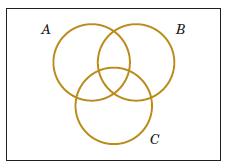
2-18. Threeattemptsaremadetoreaddatainamagneticstoragedevicebeforeanerrorrecoveryprocedurethat repositions themagneticheadisused.Theerrorrecoveryprocedureattemptsthreerepositioningsbeforean“abort’’ messageissenttotheoperator.Let
s denotethesuccessofareadoperation
f denotethefailureofareadoperation
S denotethesuccessofanerrorrecoveryprocedure
F denotethefailureofanerrorrecoveryprocedure
A denoteanabortmessagesenttotheoperator
Describethesamplespaceofthisexperimentwithatreediagram.
2-19 ThreeeventsareshownontheVenndiagraminthefollowingfigure:
Reproducethefigureandshadetheregionthatcorrespondstoeachofthefollowingevents.
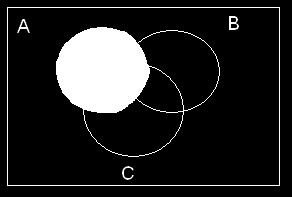
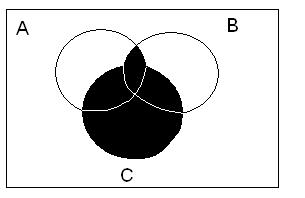
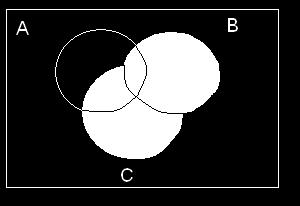
2-20. ThreeeventsareshownontheVenndiagraminthefollowingfigure:
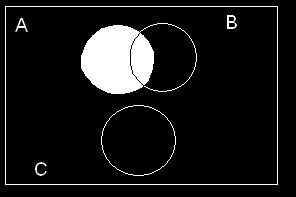
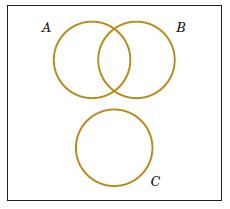
Reproducethefigureandshadetheregionthatcorrespondstoeachofthefollowingevents.
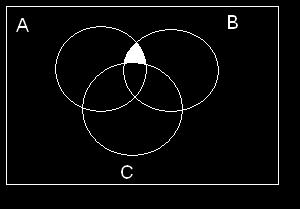
(d)
(e)
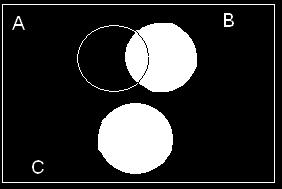
2-21. Adigitalscalethatprovidesweightstothenearestgramisused.
(a) Whatisthesamplespaceforthisexperiment?
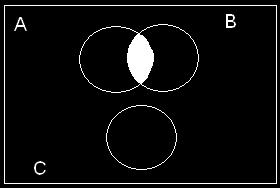
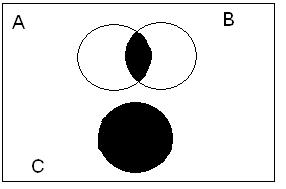
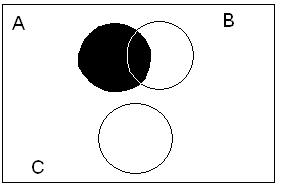
Let A denotetheeventthataweightexceeds11grams,let B denotetheeventthataweightislessthanor equalto 15grams,andlet C denotetheeventthataweightisgreaterthanorequalto8gramsandlessthan12 grams.
Describethefollowingevents.
(a) Let S = the nonnegative integers from 0 to the largest integer that can be displayed by the scale. Let X denote the weight.
A is the event that X > 11 B is the event that X 15 C is the event that 8 X <12 S = {0, 1, 2, 3, …}
(b) S
(c) 11 < X 15 or {12, 13, 14, 15}
(d) X 11 or {0, 1, 2, …, 11}
(e) S
(f) A C contains the values of X such that: X 8 Thus (A C) contains the values of X such that: X < 8 or {0, 1, 2, …, 7}
(g)
(h) B contains the values of X such that X > 15. Therefore, B C is the empty set. They have no outcomes in common or .
(i) B C is the event 8 X <12. Therefore, A (B C) is the event X 8 or {8, 9, 10, …}
2-22. Inaninjection-moldingoperation,thelengthandwidth,denotedas X and Y ,respectively,ofeachmoldedpart areevaluated.Let
A denotetheeventof48< X <52centimeters
B denotetheeventof9< Y <11centimeters
ConstructaVenndiagramthatincludestheseevents.Shadetheareasthatrepresentthefollowing:
(a) A (b) A B (c) A B (d) A B
(e)Iftheseeventsweremutuallyexclusive,howsuccessfulwouldthisproductionoperationbe?Wouldthe process producepartswith X 50centimetersand Y =10centimeters?
(e) If the events are mutually exclusive, then AB is the null set. Therefore, the process does not produce product parts with X = 50 cm and Y = 10 cm. The process would not be successful
2-23. Fourbitsaretransmittedoveradigitalcommunicationschannel.Eachbitiseitherdistortedorreceivedwithout distortion.Let Ai denotetheeventthatthe ithbitisdistorted, i 1, ,4.
(a)Describethesamplespaceforthisexperiment.
(b)Arethe Ai’smutuallyexclusive?
Describetheoutcomesineachofthefollowingevents:
Let d and o denote a distorted bit and one that is not distorted (o denotes okay), respectively.
2-24 Inlight-dependentphotosynthesis,lightqualityreferstothewavelengthsoflightthatareimportant.The wavelength ofasampleofphotosyntheticallyactiveradiations(PAR)ismeasuredtothenearestnanometer.Theredrangeis 675–700nmandthebluerangeis450–500nm.Let A denotetheeventthatPARoccursintheredrange,andlet B denotetheeventthatPARoccursinthebluerange.Describethesamplespaceandindicateeachofthe followingevents:
(a) A (b) B (c) A B (d) A B
Let w denote the wavelength. The sample space is {w | w = 0, 1, 2, …}
(a) A={w | w = 675, 676, …, 700 nm}


(b) B={ w | w = 450, 451, …, 500 nm}
(c) B A
(d) B A {w | w = 450, 451, …, 500, 675, 676, …, 700 nm}
2-25 Incontrolreplication,cellsarereplicatedoveraperiodoftwodays.Notuntilmitosisiscompletedcan freshlysynthesizedDNAbereplicatedagain.Twocontrolmechanismshavebeenidentified onepositiveand one negative.Supposethatareplicationisobservedinthreecells.Let A denotetheeventthatallcellsareidentified as positive,andlet B denotetheeventthatallcellsarenegative.Describethesamplespacegraphicallyanddisplay each ofthefollowingevents:
(a) A (b) B (c) A B (d) A B
Let P and N denote positive and negative, respectively. The sample space is {PPP, PPN, PNP, NPP, PNN, NPN, NNP, NNN}.
(a) A={ PPP }
(b) B={ NNN }
(c) B A
(d) B A { PPP , NNN }
2-26. Disksofpolycarbonateplasticfromasupplierareanalyzedforscratchandshockresistance.Theresultsfrom 100 disksaresummarizedhere:
Let A denotetheeventthatadiskhashighshockresistance,andlet B denotetheeventthatadiskhashigh scratchresistance.Determinethenumberofdisksin A B, A , and A B
A B = 70, A = 14, A B = 95
2-27. Samplesofacastaluminumpartareclassifiedonthebasisofsurfacefinish(inmicroinches)andedgefinish.The resultsof100partsaresummarizedasfollows:
(a)Let A denotetheeventthatasamplehasexcellentsurfacefinish,andlet B denotetheeventthatasamplehas excellentedgefinish.Determinethenumberofsamplesin A B, B andin A B
(b)Assumethateachoftwosamplesistobeclassifiedonthebasisofsurfacefinish,eitherexcellentorgood,and on thebasisofedgefinish,eitherexcellentorgood.Useatreediagramtorepresentthepossibleoutcomesof thisexperiment.
(a) B A = 10, B =10, B A = 92
(b)
2-28. Samplesofemissionsfromthreesuppliersareclassifiedforconformancetoair-qualityspecifications.The results from100samplesaresummarizedasfollows:
Let A denotetheeventthatasampleisfromsupplier1,andlet B denotetheeventthatasampleconformsto specifications.Determinethenumberofsamplesin A B, B andin A B
B A = 55, B =23, B A = 85

2-29. Therisetimeofareactorismeasuredinminutes(andfractionsofminutes).Letthesamplespacebepositive, realnumbers.Definetheevents A and B asfollows:
A x | x 725and B x | x 525
Describeeachofthefollowingevents:
(a) A (b) B (c)
(a) A = {x | x 72.5}
(b) B = {x | x 52.5}
(c) A B = {x | 52.5 < x < 72.5}
(d) A B = {x | x > 0}
2-30 Asampleoftwoitemsisselectedwithoutreplacementfromabatch.Describethe(ordered)samplespacefor eachofthefollowingbatches:
(a)Thebatchcontainstheitems{a, b, c, d}.
(b)Thebatchcontainstheitems{a, b, c, d, e, f , g}.
(c)Thebatchcontains4defectiveitemsand20gooditems.
(d)Thebatchcontains1defectiveitemand20gooditems.
(a) {ab, ac, ad, bc, bd, cd, ba, ca, da, cb, db, dc}
(b) {ab, ac, ad, ae, af, ag, ba, bc, bd, be, bf, bg, ca, cb, cd, ce, cf, cg, da, db, dc, de, df, dg, ea, eb, ec, ed, ef, eg, fa, fb, fc, fg, fd, fe, ga, gb, gc, gd, ge, gf}, contains 42 elements
(c) Let d and g denote defective and good, respectively. Then S = {gg, gd, dg, dd}
(d) S = {gd, dg, gg}
2-31 Asampleoftwoprintedcircuitboardsisselectedwithoutreplacementfromabatch.Describethe(ordered) samplespaceforeachofthefollowingbatches:
(a)Thebatchcontains90boardsthatarenotdefective,8boardswithminordefects,and2boardswithmajor defects.
(b)Thebatchcontains90boardsthatarenotdefective,8boardswithminordefects,and1boardwithmajor defects.
Let g denote a good board, m a board with minor defects, and j a board with major defects.
(a) S = {gg, gm, gj, mg, mm, mj, jg, jm, jj}
(
b) S ={gg,gm,gj,mg,mm,mj,jg,jm}
2-32. CountsoftheWebpagesprovidedbyeachoftwocomputerserversinaselectedhourofthedayarerecorded. Let A denotetheeventthatatleast10pagesareprovidedbyserver1,andlet B denotetheeventthatatleast20pages areprovidedbyserver2.Describethesamplespaceforthenumbersofpagesforthetwoserversgraphicallyin an x y plot.Showeachofthefollowingeventsonthesamplespacegraph:
(a) A (b) B (c) A B (d) A B
(a) The sample space contains all points in the nonnegative X-Y plane.
2-33 Areactor’srisetimeismeasuredinminutes(andfractionsofminutes).Letthesamplespacefortherisetimeof each batchbepositive,realnumbers.Considertherisetimesof two batches.Let A denotetheeventthattherisetime ofbatch1islessthan72.5minutes,andlet B denotetheeventthattherisetimeofbatch2isgreaterthan52.5 minutes.
Describethesamplespacefortherisetimeoftwobatchesgraphicallyandshoweachofthefollowingeventson atwodimensionalplot:
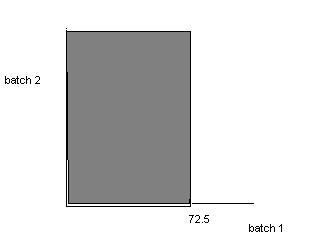
2-34. Awirelessgaragedooropenerhasacodedeterminedbytheupordownsettingof12switches.Howmany outcomesareinthesamplespaceofpossiblecodes?
212 = 4096
2-35. Anorderforacomputercanspecifyanyoneoffivememorysizes,anyoneofthreetypesofdisplays,andany one offoursizesofaharddisk,andcaneitherincludeornotincludeapentablet.Howmanydifferentsystemscan beordered?
From the multiplication rule, the answer is 5 3 4 2 120
2-36. Inamanufacturingoperation,apartisproducedbymachining,polishing,andpainting.Iftherearethree machine tools,fourpolishingtools,andthreepaintingtools,howmanydifferentroutings(consistingofmachining, followedbypolishing,andfollowedbypainting)forapartarepossible?
From the multiplication rule, 3 4 3 36
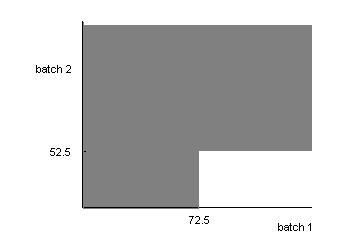
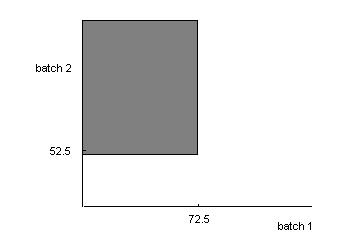

2-37. Newdesignsforawastewatertreatmenttankhaveproposedthreepossibleshapes,fourpossiblesizes,three locations forinputvalves,andfourlocationsforoutputvalves.Howmanydifferentproductdesignsarepossible?
From the multiplication rule, 3 4 3 4 144
2-38. Amanufacturingprocessconsistsof10operationsthatcanbecompletedinanyorder.Howmanydifferent production sequencesarepossible?
From equation 2-1, the answer is 10! = 3,628,800
2-39. Amanufacturingoperationconsistsof10operations.However,fivemachiningoperationsmustbecompleted beforeanyoftheremainingfiveassemblyoperationscanbegin.Withineachsetoffive,operationscanbe completedinanyorder.Howmanydifferentproductionsequencesarepossible?
From the multiplication rule and equation 2-1, the answer is 5!5! = 14,400
2-40. Inasheetmetaloperation,threenotchesandfourbendsarerequired.Iftheoperationscanbedoneinany order, howmanydifferentwaysofcompletingthemanufacturingarepossible?
From equation 2-3, 7 3 4 35 ! ! ! sequences are possible
2-41. Abatchof140semiconductorchipsisinspectedbychoosingasampleof5chips.Assume10ofthechipsdonot conformtocustomerrequirements.
(a)Howmanydifferentsamplesarepossible?
(b)Howmanysamplesoffivecontainexactlyonenonconformingchip?
(c)Howmanysamplesoffivecontainatleastonenonconformingchip?
(a) From equation 2-4, the number of samples of size five is
(b) There are 10 ways of selecting one nonconforming chip and there are
ways of selecting four conforming chips. Therefore, the number of samples that contain exactly one nonconforming chip is 10
(c) The number of samples that contain at least one nonconforming chip is the total number of samples
5 140 minus the number of samples that contain no nonconforming chips
That is
2-42. Inthelayoutofaprintedcircuitboardforanelectronicproduct,12differentlocationscanaccommodatechips.
(a)Iffivedifferenttypesofchipsaretobeplacedontheboard,howmanydifferentlayoutsarepossible?
(b)Ifthefivechipsthatareplacedontheboardareofthesametype,howmanydifferentlayoutsarepossible?
(a) If the chips are of different types, then every arrangement of 5 locations selected from the 12 results in a different layout. Therefore, 95,040 7! 12! 12 5 P layouts are possible.
(b) If the chips are of the same type, then every subset of 5 locations chosen from the 12 results in a different
layout. Therefore,
792 5!7! 12! 12 5 layouts are possible.
2-43. Inthelaboratoryanalysisofsamplesfromachemicalprocess,fivesamplesfromtheprocessareanalyzeddaily. In addition,acontrolsampleisanalyzedtwiceeachdaytocheckthecalibrationofthelaboratoryinstruments.
(a)Howmanydifferentsequencesofprocessandcontrolsamplesarepossibleeachday?Assumethatthefive process samplesareconsideredidenticalandthatthetwocontrolsamplesareconsideredidentical.
(b)Howmanydifferentsequencesofprocessandcontrolsamplesarepossibleifweconsiderthefiveprocess samples tobedifferentandthetwocontrolsamplestobeidentical?
(c)Forthesamesituationaspart(b),howmanysequencesarepossibleifthefirsttestofeachdaymustbea control sample?
(a) 21 2!5! 7! sequences are possible.
(b) 2520 1!1!1!1!1!2! 7! sequences are possible.
(c) 6! = 720 sequences are possible.
2-44. Inthedesignofanelectromechanicalproduct,12componentsaretobestackedintoacylindricalcasingina manner thatminimizestheimpactofshocks.Oneendofthecasingisdesignatedasthebottomandtheotherendisthe top.
(a)Ifallcomponentsaredifferent,howmanydifferentdesignsarepossible?
(b)Ifsevencomponentsareidenticaltooneanother,buttheothersaredifferent,howmanydifferentdesigns are possible?
(c)Ifthreecomponentsareofonetypeandidenticaltooneanother,andfourcomponentsareofanothertype and identicaltooneanother,buttheothersaredifferent,howmanydifferentdesignsarepossible?
(a) Every arrangement selected from the 12 different components comprises a different design. Therefore, 479,001,600 12! designs are possible.
(b) 7 components are the same, others are different, 95040 7!1!1!1!1!1! 12! designs are possible.
(c) 3326400 3!4! 12! designs are possible
2-45. Considerthedesignofacommunicationsystem.
(a)Howmanythree-digitphoneprefixesthatareusedtorepresentaparticulargeographicarea(suchasanarea code) canbecreatedfromthedigits0through9?
(b)Asinpart(a),howmanythree-digitphoneprefixesarepossiblethatdonotstartwith0or1,butcontain0or 1as themiddledigit?
(c)Howmanythree-digitphoneprefixesarepossibleinwhichnodigitappearsmorethanonceineachprefix?
(a) From the multiplication rule, 103 1000 prefixes are possible
(b) From the multiplication rule, 8 2 10 160 are possible
(c) Every arrangement of three digits selected from the 10 digits results in a possible prefix.
P3 10 10 7 720 ! ! prefixes are possible.
2-46. A byte isasequenceofeightbitsandeachbitiseither0or1.
(a)Howmanydifferentbytesarepossible?
(b)Ifthefirstbitofabyteisaparitycheck,thatis,thefirstbyteisdeterminedfromtheothersevenbits,how many differentbytesarepossible?
(a) From the multiplication rule, 2 256 8 bytes are possible
(b) From the multiplication rule, 2 128 7 bytes are possible
2-47. Inachemicalplant,24holdingtanksareusedforfinalproductstorage.Fourtanksareselectedatrandomand without replacement.Supposethatsixofthetankscontainmaterialinwhichtheviscosityexceedsthecustomer requirements.
(a)Whatistheprobabilitythatexactlyonetankinthesamplecontainshigh-viscositymaterial?
(b)Whatistheprobabilitythatatleastonetankinthesamplecontainshigh-viscositymaterial?
(c)Inadditiontothesixtankswithhighviscositylevels,fourdifferenttankscontainmaterialwithhigh impurities. Whatistheprobabilitythatexactlyonetankinthesamplecontainshigh-viscositymaterialandexactlyone tankin thesamplecontainsmaterialwithhighimpurities?
2-48. Plasticpartsproducedbyaninjection-moldingoperationarecheckedforconformancetospecifications.Each toolcontains12cavitiesinwhichpartsareproduced,andthesepartsfallintoaconveyorwhenthepressopens. Aninspectorchooses3partsfromamongthe12atrandom.Twocavitiesareaffectedbyatemperature malfunctionthatresultsinpartsthatdonotconformtospecifications.
(a)Howmanysamplescontainexactly1nonconformingpart?
(b)Howmanysamplescontainatleast1nonconformingpart?
2-49. Abinof50partscontains5thataredefective.Asampleof10partsisselectedatrandom,withoutreplacement. How manysamplescontainatleastfourdefectiveparts?
From the 5 defective parts, select 4, and the number of ways to complete this step is 5!/(4!1!) = 5
From the 45 non-defective parts, select 6, and the number of ways to complete this step is 45!/(6!39!) = 8,145,060
Therefore, the number of samples that contain exactly 4 defective parts is 5(8,145,060) = 40,725,300
Similarly, from the 5 defective parts, the number of ways to select 5 is 5!(5!1!) = 1
From the 45 non-defective parts, select 5, and the number of ways to complete this step is 45!/(5!40!) = 1,221,759
Therefore, the number of samples that contain exactly 5 defective parts is 1(1,221,759) = 1,221,759
Therefore, the number of samples that contain at least 4 defective parts is 40,725,300 + 1,221,759 = 41,947,059
2-50. Thefollowingtablesummarizes204endothermicreactionsinvolvingsodiumbicarbonate.
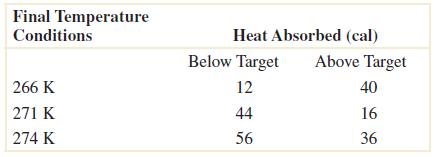
Let A denotetheeventthatareaction’sfinaltemperatureis271Korless.Let B denotetheeventthattheheat absorbedisbelowtarget.Determinethenumberofreactionsineachofthefollowingevents.
A B = 56 (b) A = 36 + 56 = 92
(c) A B = 40 + 12 + 16 + 44 + 56 = 168
(d) A B = 40+12+16+44+36=148
(e) A
B = 36
2-51. AWebadcanbedesignedfromfourdifferentcolors,threefonttypes,fivefontsizes,threeimages,andfivetext phrases.Howmanydifferentdesignsarepossible? Total number of possible designs = 900
2-52. Considerthehospitalemergencydepartmentdatagivenbelow.Let A denotetheeventthatavisitistohospital 1,and let B denotetheeventthatavisitresultsinadmittancetoanyhospital.
Determinethenumberofpersonsineachofthefollowingevents.
2-53. Anarticlein The Journal of Data Science [“AStatisticalAnalysisofWellFailuresinBaltimoreCounty”(2009,Vol. 7, pp.111–127)]providedthefollowingtableofwellfailuresfordifferentgeologicalformationgroupsin BaltimoreCounty.
Let A denotetheeventthatthegeologicalformationhasmorethan1000wells,andlet B denotetheeventthata wellfailed.Determinethenumberofwellsineachofthefollowingevents.
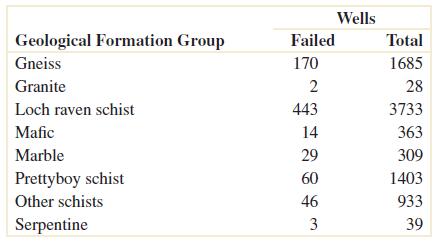
2-54. Ahospitaloperatingroomneedstoschedulethreekneesurgeriesandtwohipsurgeriesinaday. Supposethatanoperatingroomneedstohandlethreeknee,fourhip,andfiveshouldersurgeries.
(a)Howmanydifferentsequencesarepossible?
(b)Howmanydifferentsequenceshaveallhip,knee,andshouldersurgeriesscheduledconsecutively?
(c)Howmanydifferentschedulesbeginandendwithakneesurgery?
(a) From the formula for the number of sequences 12! 3!4!5! = 27,720 sequences are possible.
(b) Combining all hip surgeries into one single unit, all knee surgeries into one single unit and all shoulder surgeries into one unit, the possible number of sequences of these units = 3! = 6
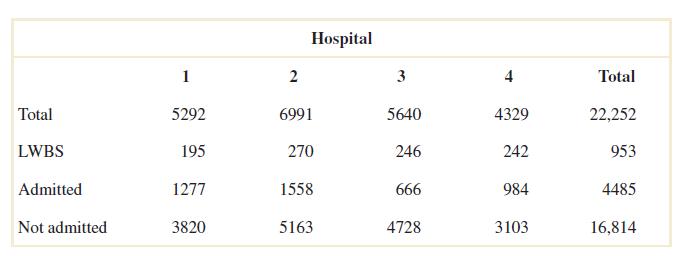
(c)With two surgeries specified, 10 remain and there are 10! 4!5!1! = 1,260 different sequences.
2-55. Considerthebarcodecode39isacommonbarcodesystemthatconsistsofnarrowandwidebars (black)separatedbyeitherwideornarrowspaces(white).Eachcharactercontainsnineelements
(fivebarsandfourspaces).Thecodeforacharacterstartsandendswithabar(eithernarrowor wide)anda(white) spaceappearsbetweeneachbar.Theoriginalspecification(sincerevised)used exactly twowidebars andonewidespaceineachcharacter.Forexample,if b and B denotenarrowandwide(black)bars, respectively,and w and W denotenarrowandwide(white)spaces,avalidcharacteris bwBwBWbwb (thenumber6).Onecodeisstillheldbackasadelimiter.Foreachofthefollowingcases,howmanycharacters canbeencoded?
(a)Theconstraintofexactlytwowidebarsisreplacedwithonethatrequiresexactlyonewidebar.
(b)Theconstraintofexactlytwowidebarsisreplacedwithonethatallowseitheroneortwowidebars.
(c)Theconstraintofexactlytwowidebarsisdropped.
(d)Theconstraintsofexactlytwowidebarsandonewidespacearedropped.
(a) The constraint of exactly two wide bars is replaced with one that requires exactly one wide bar. Focus first on the bars. There are 5!/(4!1!) = 5 permutations of the bars with one wide bar and four narrow bars. As in the example, the number of permutations of the spaces = 4. Therefore, the possible number of codes = 5(4) = 20, and if one is held back as a delimiter, 19 characters can be coded.
(b) The constraint of exactly two wide bars is replaced with one that allows either one or two wide bars. As in the example, the number of codes with exactly two wide bars = 40. From part (a), the number of codes with exactly one wide bar = 20. Therefore, is the possible codes are 40 + 20 = 60, and if one code is held back as a delimiter, 59 characters can be coded.
(c) The constraint of exactly two wide bars is dropped. There are 2 choices for each bar (wide or narrow) and 5 bars are used in total. Therefore, the number of possibilities for the bars = 25 = 32. As in the example, there are 4 possibilities for the spaces. Therefore, the number of codes is 32(3) = 128, and if one is held back as a delimiter, 127 characters can be coded.
(d) The constraints of exactly 2 wide bars and 1 wide space is dropped. As in part (c), there are 32 possibilities for the bars, and there are also 24 = 16 possibilities for the spaces. Therefore, 32(16) = 512 codes are possible, and if one is held back as a delimiter, 511 characters can be coded.
2-56. Acomputersystemusespasswordsthatcontainexactlyeightcharacters,andeachcharacteris1ofthe26 lowercase letters(a–z)or26uppercaseletters(A–Z)or10integers(0–9).Let denotethesetofallpossiblepasswords, andlet A and B denotetheeventsthatconsistofpasswordswithonlylettersoronlyintegers,respectively. Determinethenumberofpasswordsineachofthefollowingevents.
(a) (b) A (c) A B
(d)Passwordsthatcontainatleast1integer
(e)Passwordsthatcontainexactly1integer
Let |A| denote the number of elements in the set A.
(a) The number of passwords in is= 628 (from multiplication rule).
(b) The number of passwords in A is |A|= 528 (from multiplication rule)
(c) A' ∩ B' = (A U B)'. Also, |A| = 528 and |B| = 108 and A ∩ B = null. Therefore, (A U B)' = 628 - 528 - 108 ≈1.65 x 1014
(d) Passwords that contain at least 1 integer = || - |A| = 628 – 528 ≈ 1.65 x 1014
(e) Passwords that contain exactly 1 integer. The number of passwords with 7 letters is 527. Also, 1 integer is selected in 10 ways, and can be inserted into 8 positions in the password. Therefore, the solution is 8(10)(527) ≈ 8.22 x 1013
2-57. Thearticle“TermEfficacyofRibavirinPlusInterferonAlfaintheTreatmentofChronicHepatitisC,” [Gastroenterology (1996,Vol.111,no.5,pp.1307–1312)],consideredtheeffectoftwotreatmentsandacontrol fortreatmentofhepatitisC.Thefollowingtableprovidesthetotalpatientsineachgroupandthenumberthat showedacomplete(positive)responseafter24weeksoftreatment.
Let A denotetheeventthatthepatientwastreatedwithribavirinplusinterferonalfa,andlet B denotetheevent thatthe responsewascomplete.Determinethenumberofpatientsineachofthefollowingevents.
(a) A (b) A B (c) A B (d) A B
Let |A| denote the number of elements in the set A.

(a) |A| = 21
(b) |A∩B| = 16
(c) |A⋃B| = A+B - (A∩B) = 21+22 – 16 = 27
(d) |A'∩B'| = 60 - |AUB| = 60 – 27 = 33
Section 2-2
2-58 Eachofthepossiblefiveoutcomesofarandomexperimentisequallylikely.Thesamplespaceis{a, b, c, d, e}.Let A denotetheevent{a, b},andlet B denotetheevent{c, d, e}.Determinethefollowing:
(a) P(A) (b) P(B) (c) P(A') (d) P(AB) (e) P(AB)
All outcomes are equally likely
(a) P(A) = 2/5
(b) P(B) = 3/5
(c) P(A') = 3/5
(d) P(AB) = 1
(e) P(AB) = P()= 0
2-59 Thesamplespaceofarandomexperimentis{a, b,c, d, e}withprobabilities0.1,0.1,0.2,0.4,and0.2,respectively. Let A denotetheevent{a, b, c},andlet B denotetheevent{c, d, e}.Determinethefollowing:
(a) P(A) (b) P(B) (c) P(A') (d) P(AB) (e) P(AB)
(a) P(A) = 0.4
(b) P(B) = 0.8
(c) P(A') = 0.6
(d) P(AB) = 1
(e) P(AB) = 0.2
2-60. Ordersforacomputeraresummarizedbytheoptionalfeaturesthatarerequestedasfollows:
(a)Whatistheprobabilitythatanorderrequestsatleastoneoptionalfeature?

(b)Whatistheprobabilitythatanorderdoesnotrequestmorethanoneoptionalfeature?
(a) 0.5 + 0.2 = 0.7
(b) 0.3 + 0.5 = 0.8
2-61 Ifthelastdigitofaweightmeasurementisequallylikelytobeanyofthedigits0through9,
(a)Whatistheprobabilitythatthelastdigitis0?
(b)Whatistheprobabilitythatthelastdigitisgreaterthanorequalto5?
(a) 1/10
(b) 5/10
2-62. Apartselectedfortestingisequallylikelytohavebeenproducedonanyoneofsixcuttingtools.
(a)Whatisthesamplespace?
(b)Whatistheprobabilitythatthepartisfromtool1?
(c)Whatistheprobabilitythatthepartisfromtool3ortool5?
(d)Whatistheprobabilitythatthepartisnotfromtool4?
(a) S = {1, 2, 3, 4, 5, 6}
(b) 1/6
(c) 2/6
(d) 5/6
2-63 Aninjection-moldedpartisequallylikelytobeobtainedfromanyoneoftheeightcavitiesonamold.
(a)Whatisthesamplespace?
(b)Whatistheprobabilitythatapartisfromcavity1or2?
(c)Whatistheprobabilitythatapartisfromneithercavity3nor4?
(a) S = {1,2,3,4,5,6,7,8}
(b) 2/8
(c) 6/8
2-64 Inanacid-basetitration,abaseoracidisgraduallyaddedtotheotheruntiltheyhavecompletelyneutralized each
other.Becauseacidsandbasesareusuallycolorless(asarethewaterandsaltproducedintheneutralization reaction),pHismeasuredtomonitorthereaction.Supposethattheequivalencepointisreachedafter approximately100mLofanNaOHsolutionhasbeenadded(enoughtoreactwithalltheaceticacidpresent)but thatreplicatesareequallylikelytoindicatefrom95to104mLtothenearestmL.Assumethatvolumesare measuredtothenearestmLanddescribethesamplespace.
(a)Whatistheprobabilitythatequivalenceisindicatedat100mL?
(b)Whatistheprobabilitythatequivalenceisindicatedatlessthan100mL?
(c)Whatistheprobabilitythatequivalenceisindicatedbetween98and102mL(inclusive)?
The sample space is {95, 96, 97,…, 103, and 104}.
(a) Because the replicates are equally likely to indicate from 95 to 104 mL, the probability that equivalence is indicated at 100 mL is 0.1.
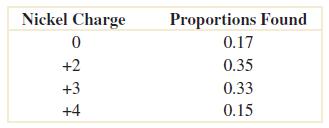
(b) The event that equivalence is indicated at less than 100 mL is {95, 96, 97, 98, 99}. The probability that the event occurs is 0.5.
(c) The event that equivalence is indicated between 98 and 102 mL is {98, 99, 100, 101, 102}. The probability that the event occurs is 0.5.
2-65 InaNiCdbattery,afullychargedcelliscomposedofnickelichydroxide.Nickelisanelementthathasmultiple oxidationstatesandthatisusuallyfoundinthefollowingstates:
(a)Whatistheprobabilitythatacellhasatleastoneofthepositivenickel-chargedoptions?
(b)Whatistheprobabilitythatacellis not composedofapositivenickelchargegreaterthan+3?
The sample space is {0, +2, +3, and +4}.
(a) The event that a cell has at least one of the positive nickel charged options is {+2, +3, and +4}. The probability is 0.35 + 0.33 + 0.15 = 0.83.

(b) The event that a cell is not composed of a positive nickel charge greater than +3 is {0, +2, and +3}. The probability is 0.17 + 0.35 + 0.33 = 0.85.
2-66 Acreditcardcontains16digitsbetween0and9.However,only100millionnumbersarevalid.Ifanumberis entered randomly,whatistheprobabilitythatitisavalidnumber?
Total possible: 1016 , but only 108 are valid. Therefore, P(valid) = 108/1016 = 1/108
2-67. Supposeyourvehicleislicensedinastatethatissueslicenseplatesthatconsistofthreedigits(between0and 9)followedbythreeletters(between A and Z).Ifalicensenumberisselectedrandomly,whatistheprobability thatyoursistheoneselected?
3 digits between 0 and 9, so the probability of any three numbers is 1/(10*10*10).
3 letters A to Z, so the probability of any three numbers is 1/(26*26*26). The probability your license plate is chosen is then (1/103)*(1/263) = 5.7 x 10-8
Amessagecanfollowdifferentpathsthroughserversonanetwork.Thesender’smessagecangotooneoffive servers forthefirststep;eachofthemcansendtofiveserversatthesecondstep;eachofthosecansendtofourservers atthethirdstep;andthenthemessagegoestotherecipient’sserver.
2-68
(a)Howmanypathsarepossible?
(b)Ifallpathsareequallylikely,whatistheprobabilitythatamessagepassesthroughthefirstoffourserversat the thirdstep?
(
a) 5*5*4 = 100
(b) (5*5)/100 = 25/100=1/4
2-69 Magnesiumalkylsareusedashomogenouscatalystsintheproductionoflinearlow-densitypolyethylene (LLDPE),whichrequiresafinermagnesiumpowdertosustainareaction.Redoxreactionexperimentsusing fourdifferentamountsofmagnesiumpowderareperformed.Eachresultmayormaynotbefurtherreducedina secondstepusingthreedifferentmagnesiumpowderamounts.Eachoftheseresultsmayormaynotbefurther reducedinathirdstepusingthreedifferentamountsofmagnesiumpowder.
(a)Howmanyexperimentsarepossible?
(b)Ifalloutcomesareequallylikely,whatistheprobabilitythatthebestresultisobtainedfromanexperiment that usesallthreesteps?
(c)Doestheresultinpart(b)changeiffiveorsixorsevendifferentamountsareusedinthefirststep?Explain.
(a) The number of possible experiments is 4 + 4 × 3 + 4 × 3 × 3 = 52
(b) There are 36 experiments that use all three steps. The probability the best result uses all three steps is 36/52 = 0.6923.
(c) No, it will not change. With k amounts in the first step the number of experiments is k + 3k + 9k = 13k The number of experiments that complete all three steps is 9k out of 13k. The probability is 9/13 = 0.6923.
2-70 Disksofpolycarbonateplasticfromasupplierareanalyzedforscratchandshockresistance.Theresultsfrom 100 disksaresummarizedasfollows:
Let A denotetheeventthatadiskhashighshockresistance,andlet B denotetheeventthatadiskhashigh scratchresistance.Ifadiskisselectedatrandom,determinethefollowingprobabilities:
(a) P(A) (b) P(B) (c) P(A') (d) P(AB) (e) P(AB) (f) P(A’B)
(a) P(A) = 86/100 = 0.86
(b) P(B) = 79/100 = 0.79
(c) P(A') = 14/100 = 0.14
(d) P(AB) = 70/100 = 0.70
(e) P(AB) = (70+9+16)/100 = 0.95
(
f) P(A’B) = (70+9+5)/100 = 0.84
2-71 Samplesofemissionsfromthreesuppliersareclassifiedforconformancetoair-qualityspecifications.The resultsfrom 100samplesaresummarizedasfollows:
Let A denotetheeventthatasampleisfromsupplier1,andlet B denotetheeventthatasampleconformsto specifications.Ifasampleisselectedatrandom,determinethefollowingprobabilities:
(a) P(A) (b) P(B) (c) P(A')
(a) P(A) = 30/100 = 0.30
(b) P(B) = 77/100 = 0.77
(c) P(A') = 1 – 0.30 = 0.70
(d) P(AB) = 22/100 = 0.22
(e) P(AB) = 85/100 = 0.85
(
f) P(A’B) =92/100 = 0.92
2-72. Anarticleinthe Journal of Database Management [“ExperimentalStudyofaSelf-TuningAlgorithmforDBMS BufferPools”(2005,Vol.16,pp.1–20)]providedtheworkloadusedintheTPC-COLTP(TransactionProcessing PerformanceCouncil’sVersionCOn-LineTransactionProcessing)benchmark,whichsimulatesatypicalorder entryapplication.
Thefrequencyofeachtypeoftransaction(inthesecondcolumn)canbeusedasthepercentageofeachtypeof transaction.Theaveragenumberof selects operationsrequiredforeachtypeoftransactionisshown.Let A denotetheeventoftransactionswithanaveragenumberof selects operationsof12orfewer.Let B denotethe eventoftransactionswithanaveragenumberof updates operationsof12orfewer.Calculatethefollowing probabilities.

(a) P(A) (b) P(B) (c) P(AB) (d) P(AB’) (f) P(AB)
(a) The total number of transactions is 43+44+4+5+4=100

2-73 Usetheaxiomsofprobabilitytoshowthefollowing: A B (d) A B
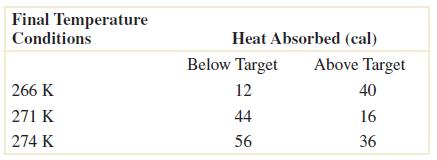
If A iscontainedin B,then
(a) Because E and E' are mutually exclusive events and E E = S 1 = P(S) = P( E E ) = P(E) + P(E'). Therefore, P(E') = 1 - P(E)
(b) Because S and are mutually exclusive events with S = S P(S) = P(S) + P(). Therefore, P() = 0
(c) Now, B = A A B ( ) and the events A and A B are mutually exclusive. Therefore, P(B) = P(A) + P( A B ). Because P( A B ) 0 , P(B) P(A).
2.74 Considertheendothermicreaction’stablegivenbelow.Let A denotetheeventthatareaction'sfinal temperatureis271Korless.Let B denotetheeventthattheheatabsorbedisabovetarget.
Determinethefollowingprobabilities.
2-75 AWebadcanbedesignedfromfourdifferentcolors,threefonttypes,fivefontsizes,threeimages,andfivetext phrases.AspecificdesignisrandomlygeneratedbytheWebserverwhenyouvisitthesite.Ifyouvisitthesite fivetimes,whatistheprobabilitythatyouwillnotseethesamedesign?
AWebadcanbedesignedfromfourdifferentcolors,threefonttypes,fivefontsizes,threeimages,andfivetext phrases.AspecificdesignisrandomlygeneratedbytheWebserverwhenyouvisitthesite.Ifyouvisitthesite fivetimes,whatistheprobabilitythatyouwillnotseethesamedesign?
Total number of possible designs is 900. The sample space of all possible designs that may be seen on five visits. This space contains 9005 outcomes.
The number of outcomes in which all five visits are different can be obtained as follows. On the first visit any one of 900 designs may be seen. On the second visit there are 899 remaining designs. On the third visit there are 898 remaining designs. On the fourth and fifth visits there are 897 and 896 remaining designs, respectively. From the multiplication rule, the number of outcomes where all designs are different is 900*899*898*897*896. Therefore, the probability that a design is not seen again is
(900*899*898*897*896)/ 9005 = 0.9889
2-76 Considerthehospitalemergencyroomdataisgivenbelow.Let A denotetheeventthatavisitistohospital4, andlet B denotetheeventthatavisitresultsinLWBS(atanyhospital).

Determinethefollowingprobabilities.
(a)
(
(a) P(A B) = 242/22252 = 0.0109
(b) P(A) = (5292+6991+5640)/22252 = 0.8055
(c) P(A B) = (195 + 270 + 246 + 242 + 984 + 3103)/22252 = 0.2265
(d) P(A B) = (4329 + (5292 – 195) + (6991 – 270) + 5640 – 246))/22252 = 0.9680
(e) P(A B) = (1277 + 1558 + 666 + 3820 + 5163 + 4728)/22252 = 0.7735
2-77 Considerthewellfailuredataisgivenbelow.Let A denotetheeventthatthegeologicalformationhasmorethan 1000wells,andlet B denotetheeventthatawellfailed.
Determinethefollowingprobabilities.
2-78. Considerthebar code39isacommonbarcodesystemthatconsistsofnarrowandwidebars (black)separatedbyeitherwideornarrowspaces(white).Eachcharactercontainsnineelements (fivebarsandfourspaces).Thecodeforacharacterstartsandendswithabar(eithernarrowor wide)anda(white)spaceappearsbetweeneachbar.Theoriginalspecification(sincerevised)used exactly twowidebarsandonewidespaceineachcharacter.Forexample,if b and B denotenarrow andwide(black)bars,respectively,and w and W denotenarrowandwide(white)spaces,avalid characteris bwBwBWbwb (thenumber6).Supposethatall40codesareequallylikely(noneisheldbackas adelimiter).
Determinetheprobabilityforeachofthefollowing:

(a)Awidespaceoccursbeforeanarrowspace.
(b)Twowidebarsoccurconsecutively.
(c)Twoconsecutivewidebarsareatthestartorend.
(d)Themiddlebariswide.
(a) There are 4 spaces and exactly one is wide.
Number of permutations of the spaces where the wide space appears first is 1.
Number of permutations of the bars is 5!/(2!3!) = 10.
Total number of permutations where a wide space occurs before a narrow space 1(10) = 10.
P(wide space occurs before a narrow space) =10/40 = 1/4
(b) There are 5 bars and 2 are wide. The spaces are handled as in part (a).
Number of permutations of the bars where 2 wide bars are consecutive is 4. Therefore, the probability is 16/40 = 0.4
(c) The spaces are handled as in part (a).
Number of permutations of the bars where the 2 consecutive wide bars are at the start or end is 2. Therefore, the probability is 8/40 = 0.2
(d) The spaces are handled as in part (a).
Number of permutations of the bars where a wide bar is at the center is 4 because there are 4 remaining positions for the second wide bar. Therefore, the probability is 16/40 = 0.4
2-79. Ahospitaloperatingroomneedstoschedulethreekneesurgeriesandtwohipsurgeriesinaday. Supposethatanoperatingroomneedstoschedulethreeknee,fourhip,andfiveshouldersurgeries.Assumethat allschedulesareequallylikely.
Determinetheprobabilityforeachofthefollowing:
(a)Allhipsurgeriesarecompletedbeforeanothertypeofsurgery.
(b)Theschedulebeginswithahipsurgery.
(c)Thefirstandlastsurgeriesarehipsurgeries.
(d)Thefirsttwosurgeriesarehipsurgeries.
2-80. Supposethatapatientisselectedrandomlyfromthethosedescribed,Thearticle“TermEfficacyofRibavirin PlusInterferonAlfaintheTreatmentofChronicHepatitisC,”[Gastroenterology (1996,Vol.111,no.5,pp.1307–1312)],consideredtheeffectoftwotreatmentsandacontrolfortreatmentofhepatitisC.Thefollowingtable providesthetotalpatientsineachgroupandthenumberthatshowedacomplete(positive)responseafter24 weeksoftreatment.
Let A denotetheeventthatthepatientisinthegrouptreatedwithinterferonalfa,andlet B denotetheevent thatthepatienthasacompleteresponse. Determinethefollowingprobabilities.

(a) P(A)= 19/60 = 0.3167
(b) P(B)= 22/60 = 0.3667
(c) P(A∩B) = 6/60 = 0.1
(d) P(AUB) = P(A)+P(B)-P(A∩B) = (19+22-6)/60 =0.5833
(e) P(A’UB) = P(A’)+P(B)-P(A’∩B) = 21+20 60 + 22 60 16 60 =07833
2-81. Acomputersystemusespasswordsthatcontainexactlyeightcharacters,andeachcharacterisoneof26 lowercase letters(a–z)or26uppercaseletters(A–Z)or10integers(0–9).Let denotethesetofallpossiblepasswords, andlet A and B denotetheeventsthatconsistofpasswordswithonlylettersoronlyintegers,respectively. Supposethat allpasswordsin areequallylikely. Determinetheprobabilityofeachofthefollowing:
(a) A (b) B
(c)Apasswordcontainsatleast1integer.
(d)Apasswordcontainsexactly2integers.
(a) P(A) = 528 628 =0.2448
(b) P(B) = 108 628 = 4.58x10-7
(c) P(contains at least 1 integer) =1 - P(password contains no integer) = 1528 628 = 0.7551
(d) P(contains exactly 2 integers)
Number of positions for the integers is 8!/(2!6!) = 28
Number of permutations of the two integers is 102 = 100
Number of permutations of the six letters is 526
Total number of permutations is 628 Therefore, the probability is 28(100)(526) 628 = 0.254 Section
(d) P(A) = P( A B ) + P( A B ). Therefore, P( A B ) = 0.3 - 0.1 = 0.2
(e) P(( A B )') = 1 - P( A B ) = 1 - 0.4 = 0.6
(f) P( A B) = P(A') + P(B) - P( A B) = 0.7 + 0.2 - 0.1 = 0.8
If A, B,and C aremutuallyexclusiveeventswith P(A)
4, determinethefollowing probabilities:
(a) P( C B A ) = P(A) + P(B) + P(C), because the events are mutually exclusive. Therefore, P( C B A ) = 0.2+0.3+0.4 = 0.9
(b) P ( C B A ) = 0, because A B C =
(c) P( B A ) = 0 , because A B =
(d) P( C B A ) ( ) = 0, because C B A ) ( =
(
(e) P( ABC ) =1-[ P(A) + P(B) + P(C)] = 1-(0.2+0.3+0.4) = 0.1
2-84 Inthearticle“ACLReconstructionUsingBone-PatellarTendon-BonePress-FitFixation:10-YearClinical Results”in Knee Surgery, Sports Traumatology, Arthroscopy (2005,Vol.13,pp.248–255),thefollowingcausesfor kneeinjurieswereconsidered:
(a)Whatistheprobabilitythatakneeinjuryresultedfromasport(contactornoncontact)?
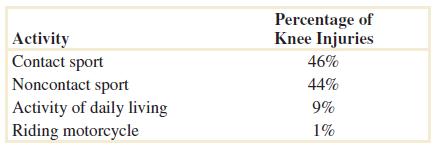
(b)Whatistheprobabilitythatakneeinjuryresultedfromanactivityotherthanasport?
(a) P(Caused by sports) = P(Caused by contact sports or by noncontact sports)
= P(Caused by contact sports) + P(Caused by noncontact sports) = 0.46 + 0.44 = 0.9
(b) 1- P(Caused by sports) = 0.1
2.85. Disksofpolycarbonateplasticfromasupplierareanalyzedforscratchandshockresistance.Theresultsfrom 100 disksaresummarizedasfollows:
(a) Ifadiskisselectedatrandom,whatistheprobabilitythatitsscratchresistanceishighanditsshock resistanceis high?
(b) Ifadiskisselectedatrandom,whatistheprobabilitythatitsscratchresistanceishighoritsshock resistanceis high?
(c) Considertheeventthatadiskhashighscratchresistanceandtheeventthatadiskhashighshock resistance.Are thesetwoeventsmutuallyexclusive?
(a) 70/100 = 0.70
(b) (79+86-70)/100 = 0.95
(c) No, P( A B ) 0
2-86. Strandsofcopperwirefromamanufacturerareanalyzedforstrengthandconductivity.Theresultsfrom100 strandsareasfollows:
(a)Ifastrandisrandomlyselected,whatistheprobabilitythatitsconductivityishighanditsstrengthishigh?
(b)Ifastrandisrandomlyselected,whatistheprobabilitythatitsconductivityisloworitsstrengthislow?
(c)Considertheeventthatastrandhaslowconductivityandtheeventthatthestrandhaslowstrength.Are thesetwo eventsmutuallyexclusive?
(a) P(High temperature and high conductivity)= 74/100 =0.74


(b) P(Low temperature or low conductivity)
= P(Low temperature) + P(Low conductivity) – P(Low temperature and low conductivity)
= (8+3)/100 + (15+3)/100 – 3/100
= 0.26
(c) No, they are not mutually exclusive. Because P(Low temperature) + P(Low conductivity) = (8+3)/100 + (15+3)/100 = 0.29, which is not equal to P(Low temperature or low conductivity).

2-87 Theanalysisofshaftsforacompressorissummarizedbyconformancetospecifications.
(a)Ifashaftisselectedatrandom,whatistheprobabilitythatitconformstosurfacefinishrequirements?
(b)Whatistheprobabilitythattheselectedshaftconformstosurfacefinishrequirementsortoroundness requirements?
(c)Whatistheprobabilitythattheselectedshafteitherconformstosurfacefinishrequirementsordoesnot conform toroundnessrequirements?
(d)Whatistheprobabilitythattheselectedshaftconformstobothsurfacefinishandroundnessrequirements?
(a) 350/370
(b) 345 5 12 370 362 370
(c) 345 5 8 370 358 370
(d) 345/370
2-88 Cookingoilisproducedintwomainvarieties:monoandpolyunsaturated.Twocommonsourcesofcookingoil are cornandcanola.Thefollowingtableshowsthenumberofbottlesoftheseoilsatasupermarket:
(a)Ifabottleofoilisselectedatrandom,whatistheprobabilitythatitbelongstothepolyunsaturatedcategory?
(b)Whatistheprobabilitythatthechosenbottleismonounsaturatedcanolaoil?
(a) 170/190 = 17/19
(b) 7/190
2-89 Amanufactureroffrontlightsforautomobilestestslampsunderahigh-humidity,high-temperature environment usingintensityandusefullifeastheresponsesofinterest.Thefollowingtableshowstheperformanceof130 lamps:
(a)Findtheprobabilitythatarandomlyselectedlampwillyieldunsatisfactoryresultsunderanycriteria.
(b)Thecustomersfortheselampsdemand95%satisfactoryresults.Canthelampmanufacturermeetthis demand?
(a) P(unsatisfactory) = (5 + 10 – 2)/130 = 13/130
(b) P(both criteria satisfactory) = 117/130 = 0.90, No

2-90 Acomputersystemusespasswordsthataresixcharacters,andeachcharacterisoneofthe26letters(a–z)or

9).Uppercaselettersarenotused.Let A denotetheeventthatapasswordbeginswithavowel (either a, e, i, o,or u),andlet B denotetheeventthatapasswordendswithanevennumber(either0,2,4,6,or 8).Supposeahackerselectsapasswordatrandom.Determinethefollowingprobabilities:
10integers(0
2-91 Considertheendothermicreactionsgivenbelow.Let A denotetheeventthatareaction'sfinaltemperatureis 271Korless.Let B denotetheeventthattheheatabsorbedisabovetarget.

Usetheadditionrulestocalculatethefollowingprobabilities.
(c) P(A B) = 1 – P(A B) = 1 – 0.2745 = 0.7255
2-92 AWebadcanbedesignedfromfourdifferentcolors,threefonttypes,fivefontsizes,threeimages,andfivetext phrases.AspecificdesignisrandomlygeneratedbytheWebserverwhenyouvisitthesite.Let A denotethe eventthatthedesigncolorisred,andlet B denotetheeventthatthefontsizeisnotthesmallestone.Usethe additionrulestocalculatethefollowingprobabilities.
(a) P(A B) (b) P(A
P(A) = 1/4 = 0.25, P(B) = 4/5 = 0.80,
2-93 Considerthehospitalemergencyroomdatagivenbelow.Let A denotetheeventthatavisitistohospital4,and let B denotetheeventthatavisitresultsinLWBS(atanyhospital).
Usetheadditionrulestocalculatethefollowingprobabilities.
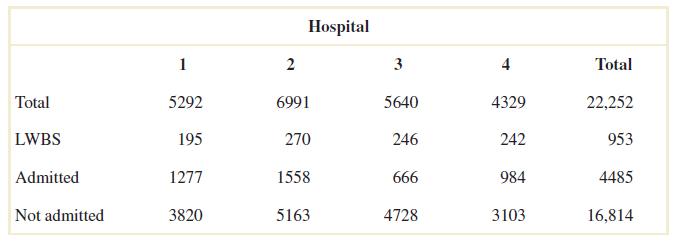
2-94 Considerthewellfailuredatagivenbelow.Let A denotetheeventthatthegeologicalformationhasmorethan 1000wells,andlet B denotetheeventthatawellfailed.
Usetheadditionrulestocalculatethefollowingprobabilities.
14 + 29 + 60 + 46 + 3)/8493 = 0.0903, P(A B) = (170 + 443 + 60)/8493 = 0.0792, P(A B) = (1515+3290+1343)/8493 = 0.7239
a) P(A B) = P(A) + P(B) – P(A B) = 0.8031 + 0.0903 – 0.0792 = 0.8142
b) P(A B) = P(A) + P(B) – P(A B) = 0.8031 + (1 – 0.0903) – 0.7239 = 0.9889
c) P(A B) = 1 – P(A B) = 1 – 0.0792 = 0.9208
2-95. Considerthebarcode39isacommonbarcodesystemthatconsistsofnarrowandwidebars (black)separatedbyeitherwideornarrowspaces(white).Eachcharactercontainsnineelements (fivebarsandfourspaces).Thecodeforacharacterstartsandendswithabar(eithernarrowor wide)anda(white)spaceappearsbetweeneachbar.Theoriginalspecification(sincerevised)used exactly twowidebarsandonewidespaceineachcharacter.Forexample,if b and B denotenarrow andwide(black)bars,respectively,and w and W denotenarrowandwide(white)spaces,avalid characteris bwBwBWbwb (thenumber6).Supposethatall40codesareequallylikely(noneisheldbackas adelimiter).
Determinetheprobabilityforeachofthefollowing:

(a)Thefirstbariswideorthesecondbariswide.
(b)Neitherthefirstnorthesecondbariswide.
(c)Thefirstbariswideorthesecondbarisnotwide.
(d)Thefirstbariswideorthefirstspaceiswide.
(a) Number of permutations of the bars with the first bar wide is 4
Number of permutations of the bars with the second bar wide is 4
Number of permutations of the bars with both the first & second bar wide is 1
Number of permutations of the bars with either the first bar wide or the last bar wide = 4 + 4 – 1 = 7
Number of codes is multiplied this by the number of permutations for the spaces = 4
P(first bar is wide) = 16/40 = 0.4, P(second bar is wide) = 16/40 = 0.4, P(first & second bar is wide) = 4/40 = 0.1
P(first or second bar is wide) = 4/10 + 4/10 – 1/10 = 7/10
(b) Neither the first or second bar wide implies the two wide bars occur in the last 3 positions.
Number of permutations of the bars with the wide bars in the last 3 positions is 3!/2!1! = 3
P(neither first nor second bar is wide) = 12/40 = 0.3
(c) The spaces are handled as in part (a).
P(first bar is wide) = 16/40 = 0.4
Number of permutations of the bars with the second bar narrow is 4!/(2!2!) = 6
P(second bar is narrow) = 24/40 = 0.6
Number of permutations with the first bar wide and the second bar narrow is 3!/(1!2!) = 3
P(first bar wide and the second bar narrow) = 12/40 = 0.3
P(first bar is wide or the second bar is narrow) = 0.4 + 0.6 – 0.3 = 0.7
(d) The spaces are handled as in part (a).
Number of permutations of the bars with the first bar wide is 4. Therefore, P(first bar is wide) = 16/40 = 0.4
The number of permutations of the bars = 10. Number of permutations of the spaces with the first space wide is 1. Therefore, P(first space is wide) = 1(10)/40 = 0.25
Number codes with the first bar wide and the first space wide is 4(1) = 4
P(first bar wide & the first space wide) = 4/40 = 0.1
P(first bar is wide or the first space is wide) = 0.4 + 0.25 – 0.1 = 0.55
2-96. Considerthethreepatientgroups.Thearticle“TermEfficacyofRibavirinPlusInterferonAlfaintheTreatment ofChronicHepatitisC,”[Gastroenterology (1996,Vol.111,no.5,pp.1307–1312)],consideredtheeffectoftwo treatmentsandacontrolfortreatmentofhepatitisC.Thefollowingtableprovidesthetotalpatientsineach groupandthenumberthatshowedacomplete(positive)responseafter24weeksoftreatment.
Let A denotetheeventthatthepatientwastreatedwithribavirinplusinterferonalfa,andlet B denotetheevent thattheresponsewascomplete.Determinethefollowingprobabilities:

(a) P(A B) (b) P(A B) (c) P(A B)
(a) P(AUB)= P(A) + P(B) - P(A∩B) = 21/60 + 22/60 – 16/60 = 9/20= 0.45
(b) P(A'UB)= P(A') + P(B) - P(A'∩B) = (19+20)/60 + 22/60 – 6/60 = 11/12 = 0.9166
(c) P(AUB')= P(A) + P(B') - P(A∩B')= 21/60 + (60-22)/60 – 5/60 = 9/10 = 0.9
2-97. Acomputersystemusespasswordsthatcontainexactlyeightcharacters,andeachcharacterisoneofthe26 lowercase letters(a–z)or26uppercaseletters(A–Z)or10integers(0–9).Assumeallpasswordsareequallylikely.Let A and B denotetheeventsthatconsistofpasswordswithonlylettersoronlyintegers,respectively.Determinethe followingprobabilities:
(a) P(A B) (b) P(A B) (c) P (Passwordcontainsexactly1or2integers)
(c) P(contains exactly 1 integer)
Number of positions for the integer is 8!/(1!7!) = 8
Number of values for the integer = 10
Number of permutations of the seven letters is 527
Total number of permutations is 628
Therefore, the probability is 8(10)(527) 628 = 0.377
P(contains exactly 2 integers)
Number of positions for the integers is 8!/(2!6!) = 28
Number of permutations of the two integers is 100
Number of permutations of the 6 letters is 526
Total number of permutations is 628
Therefore, the probability is
28(100)(526) 628 = 0.254
Therefore, P(exactly one integer or exactly two integers) = 0.377 + 0.254 = 0.630

2-98. Thearticle[“ClinicalandRadiographicOutcomesofFourDifferentTreatmentStrategiesinPatientswithEarly RheumatoidArthritis,” Arthritis & Rheumatism (2005,Vol.52,pp.3381–3390)]consideredfourtreatment groups.Thegroupsconsistedofpatientswithdifferentdrugtherapies(suchasprednisoneandinfliximab): sequentialmonotherapy(group1),step-upcombinationtherapy(group2),initialcombinationtherapy(group 3),orinitialcombinationtherapywithinfliximab(group4).Radiographsofhandsandfeetwereusedto evaluatediseaseprogression.Thenumberofpatientswithoutprogressionofjointdamagewas76of114 patients(67%),82of112patients(73%),104of120patients(87%),and113of121patients(93%)ingroups 1–4,respectively.Supposethatapatientisselectedrandomly.Let A denotetheeventthatthepatientisingroup 1,andlet B denotetheeventthatthereisnoprogression.Determinethefollowingprobabilities:
(a) P(A B) (b) P(A
P(A)= 114 114+112+120+121 = 114 467 =0244
P(B)= 76+82+104+113 114+112+120+121 = 375 467 =08029
P(A∩B)= 76 467 =0.162
(a) P(AUB) = P(A) + P(B) - P(A∩B)= 114/467 + 375/467 – 76/467 = 0.884
(b) P(A'UB') = 1 - (A∩B) = 1 – 76/467 =0.838
(c) P(AUB') = P(A) + P(B') - P(A∩B') = 114/467 + (1 – 375/467) – (114 – 76)/467 = 0.359
Section 2-4
2-99 Disksofpolycarbonateplasticfromasupplierareanalyzedforscratchandshockresistance.Theresultsfrom 100 disksaresummarizedasfollows:
Let A denotetheeventthatadiskhashighshockresistance,andlet B denotetheeventthatadiskhashigh scratchresistance.Determinethefollowingprobabilities:
(a) PA (b) PB (c) PA | B (d) PB | A
(a) P(A) = 86/100
(b) P(B) = 79/100
(c)
2-100. Samplesofskinexperiencingdesquamationareanalyzedforbothmoistureandmelanincontent.Theresults from100skinsamplesareasfollows:
Let A denotetheeventthatasamplehaslowmelanincontent,andlet B denotetheeventthatasamplehashigh moisturecontent.Determinethefollowingprobabilities:
2-101 Theanalysisofresultsfromaleaftransmutationexperiment(turningaleafintoapetal)issummarizedbytype of transformationcompleted:



(a)Ifaleafcompletesthecolortransformation,whatistheprobabilitythatitwillcompletethetextural transformation?
(b)Ifaleafdoesnotcompletethetexturaltransformation,whatistheprobabilityitwillcompletethecolor transformation?
Let A denote the event that a leaf completes the color transformation and let B denote the event that a leaf completes the textural transformation. The total number of experiments is 300.
2-102 Samplesofacastaluminumpartareclassifiedonthebasisofsurfacefinish(inmicroinches)andlength measurements.Theresultsof100partsaresummarizedasfollows:
Let A denotetheeventthatasamplehasexcellentsurfacefinish,andlet B denotetheeventthatasamplehas excellent length.Determine:
(a) PA
(b) PB (c) PA | B (d) PB | A
(e)Iftheselectedparthasexcellentsurfacefinish,whatistheprobabilitythatthelengthisexcellent?
(f)Iftheselectedparthasgoodlength,whatistheprobabilitythatthesurfacefinishisexcellent?
(a) 0.82
(b) 0.90
(c) 8/9 = 0.889
(d) 80/82 = 0.9756
(e) 80/82 = 0.9756
(f) 2/10 = 0.20
2-103. Thefollowingtablesummarizestheanalysisofsamplesofgalvanizedsteelforcoatingweightandsurface roughness:
(a)Ifthecoatingweightofasampleishigh,whatistheprobabilitythatthesurfaceroughnessishigh?
(b)Ifthesurfaceroughnessofasampleishigh,whatistheprobabilitythatthecoatingweightishigh?
(c)Ifthesurfaceroughnessofasampleislow,whatistheprobabilitythatthecoatingweightislow?
(a) 12/100 (b) 12/28 (c) 34/122
2-104 ConsiderthedataonwafercontaminationandlocationinthesputteringtoolshowninTable2-2.Assumethat onewaferisselectedatrandomfromthisset.Let A denotetheeventthatawafercontainsfourormore particles,andlet B denotetheeventthatawaferisfromthecenterofthesputteringtool.Determine:
2-105 Thefollowingtablesummarizesthenumberofdeceasedbeetlesunderautolysis(thedestructionofacellafter itsdeathbytheactionofitsownenzymes)andputrefaction(decompositionoforganicmatter,especiallyprotein, by microorganisms,resultinginproductionoffoul-smellingmatter):
(a)Iftheautolysisofasampleishigh,whatistheprobabilitythattheputrefactionislow?
(b)Iftheputrefactionofasampleishigh,whatistheprobabilitythattheautolysisishigh?
(c)Iftheputrefactionofasampleislow,whatistheprobabilitythattheautolysisislow?
Let A denote the event that autolysis is high and let B denote the event that putrefaction is high. The total number of experiments is 100.


2-106 Amaintenancefirmhasgatheredthefollowinginformationregardingthefailuremechanismsforair conditioning systems:
Theunitswithoutevidenceofgasleaksorelectricalfailureshowedothertypesoffailure.Ifthisisa representativesampleofACfailure,findtheprobability
(a)Thatfailureinvolvesagasleak
(b)Thatthereisevidenceofelectricalfailuregiventhattherewasagasleak
(c)Thatthereisevidenceofagasleakgiventhatthereisevidenceofelectricalfailure
(a) P(gas leak) = (55 + 32)/107 = 0.813
(b) P(electric failure | gas leak) = (55/107)/(87/102) = 0.632
(c) P(gas leak | electric failure) = (55/107)/(72/107) = 0.764
2-107 Alotof100semiconductorchipscontains20thataredefective.Twoareselectedrandomly,without replacement, fromthelot.
(a)Whatistheprobabilitythatthefirstoneselectedisdefective?

(b)Whatistheprobabilitythatthesecondoneselectedisdefectivegiventhatthefirstonewasdefective?
(c)Whatistheprobabilitythatbotharedefective?
(d)Howdoestheanswertopart(b)changeifchipsselectedwerereplacedpriortothenextselection?
(a) 20/100
(b) 19/99
(c) (20/100)(19/99) = 0.038
(d) If the chips were replaced, the probability would be (20/100) = 0.2
2-108 Abatchof500containersforfrozenorangejuicecontains5thataredefective.Twoareselected,atrandom, without replacementfromthebatch.
(a)Whatistheprobabilitythatthesecondoneselectedisdefectivegiventhatthefirstonewasdefective?
(b)Whatistheprobabilitythatbotharedefective?
(c)Whatistheprobabilitythatbothareacceptable? Threecontainersareselected,atrandom,withoutreplacement,fromthebatch.
(d)Whatistheprobabilitythatthethirdoneselectedisdefectivegiventhatthefirstandsecondonesselected were defective?
(e)Whatistheprobabilitythatthethirdoneselectedisdefectivegiventhatthefirstoneselectedwasdefective andthe secondoneselectedwasokay?
(f)Whatistheprobabilitythatallthreearedefective?
(a) 4/499 = 0.0080
(b) (5/500)(4/499) = 0.000080
(c) (495/500)(494/499) = 0.98
(d) 3/498 = 0.0060
(e) 4/498 = 0.0080
(f)
2-109 Abatchof350samplesofrejuvenatedmitochondriacontains8thataremutated(ordefective).Twoareselected fromthebatch,atrandom,withoutreplacement.
(a)Whatistheprobabilitythatthesecondoneselectedisdefectivegiventhatthefirstonewasdefective?
(b)Whatistheprobabilitythatbotharedefective?
(c)Whatistheprobabilitythatbothareacceptable?
(a) P = (8-1)/(350-1)=0.020
(b) P = (8/350)[(8-1)/(350-1)]=0.000458
(c) P = (342/350) [(342-1)/(350-1)]=0.9547
2-110 Acomputersystemusespasswordsthatareexactlysevencharactersandeachcharacterisoneofthe26letters (a–z) or10integers(0–9).Youmaintainapasswordforthiscomputersystem.Let A denotethesubsetofpasswords thatbeginwithavowel(either a, e, i, o,or u)andlet B denotethesubsetofpasswordsthatendwithaneven number(either0,2,4,6,or8).
(a)Supposeahackerselectsapasswordatrandom.Whatistheprobabilitythatyourpasswordisselected?
(b)Supposeahackerknowsthatyourpasswordisinevent A andselectsapasswordatrandomfromthis subset.What istheprobabilitythatyourpasswordisselected?
(c)Supposeahackerknowsthatyourpasswordisin A and Bandselectsapasswordatrandomfromthissubset. What istheprobabilitythatyourpasswordisselected?
2-112 Suppose A and B aremutuallyexclusiveevents.ConstructaVenndiagramthatcontainsthethreeevents A, B, and C suchthat P
1and
2-113. Considertheendothermicreactionsgivenbelow.Let A denotetheeventthatareaction'sfinaltemperatureis 271
orless.Let B denotetheeventthattheheatabsorbedisabovetarget.
Determinethefollowingprobabilities.
2-114 Considerthehospitalemergencyroomdatagivenbelow.Let A denotetheeventthatavisitistohospital4,and let B denotetheeventthatavisitresultsinLWBS(atanyhospital).
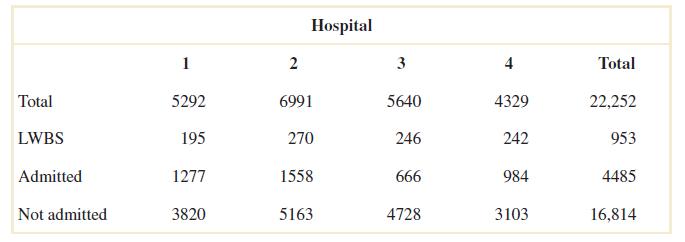
Determinethefollowingprobabilities.
2-115 Considerthewellfailuredatagivenbelow

(a)Whatistheprobabilityofafailuregiventherearemorethan1,000wellsinageologicalformation?

(b)Whatistheprobabilityofafailuregiventherearefewerthan500wellsinageologicalformation?
Also the probability of failure for fewer than 1000 wells is
(b) Let C denote the event that fewer than 500 wells are present.
2-116 Anarticleinthe The Canadian Entomologist (Harcourtetal.,1977,Vol.109,pp.1521–1534)reportedonthe lifeofthealfalfaweevilfromeggstoadulthood.Thefollowingtableshowsthenumberoflarvaethatsurvivedat each stageofdevelopmentfromeggstoadults.
(a)Whatistheprobabilityaneggsurvivestoadulthood?
(b)Whatistheprobabilityofsurvivaltoadulthoodgivensurvivaltothelatelarvaestage?
(c)Whatstagehasthelowestprobabilityofsurvivaltothenextstage?
Let A denote the event that an egg survives to an adult
Let EL denote the event that an egg survives at early larvae stage
Let LL denote the event that an egg survives at late larvae stage
Let PP denote the event that an egg survives at pre-pupae larvae stage
Let LP denote the event that an egg survives at late pupae stage

The late larvae stage has the lowest probability of survival to the pre-pupae stage.
2-117. Considerthebarcode39isacommonbarcodesystemthatconsistsofnarrowandwidebars(black) separatedbyeitherwideornarrowspaces(white).Eachcharactercontainsnineelements(fivebars andfourspaces).Thecodeforacharacterstartsandendswithabar(eithernarroworwide)anda (white) spaceappearsbetweeneachbar.Theoriginalspecification(sincerevised)used exactly twowidebars andonewidespaceineachcharacter.Forexample,if b and B denotenarrowandwide(black)bars, respectively,and w and W denotenarrowandwide(white)spaces,avalidcharacteris bwBwBWbwb (thenumber6)..Supposethatall40codesareequallylikely(noneisheldbackasadelimiter). Determinetheprobabilityforeachofthefollowing:
(a)Thesecondbariswidegiventhatthefirstbariswide.
(b)Thethirdbariswidegiventhatthefirsttwobarsarenotwide.
(c)Thefirstbariswidegiventhatthelastbariswide.
(a) A = permutations with first bar wide, B = permutations with second bar wide P(B|A) = ��(��∩��) ��(��)
There are 5 bars and 2 are wide. Number of permutations of the bars with 2 wide and 3 narrow bars is 5!/(2!3!) = 10
Number of permutations of the 4 spaces is 4!/(1!3!) = 4
Number of permutations of the bars with the first bar wide is 4!/(3!1!) = 4. Spaces are handled as previously. Therefore,
P(A) = 16/40 = 0.4
Number of permutations of the bars with the first and second bar wide is 1. Spaces are handled as previously.
Therefore, P(A ∩ B) = 4/40 = 0.1
Therefore, P(B|A) = 0.1/0.4 = 0.25
Or can use the fact that if the first bar is wide there are 4 other equally likely positions for the wide bar. Therefore, P(B|A) = 0.25
(b) A = first two bars not wide, B = third bar wide
P(B|A) = ��(��∩��) ��(��)
Number of permutations of the bars with the first two bars not wide is 3!/2!1! = 3. Spaces are handled as in part (a).
Therefore, P(A) = 12/40 =0.3
Number of permutations of the bars with the first two bars not wide and the third bar wide is 2. Spaces are handled as in part (a). Therefore, P(A ∩ B) = 8/40
Therefore, P(B|A) = 0.2/0.3 = 2/3
Or can use the fact that if the first two bars are not wide, there are only 3 equally likely positions for the 2 wide bars and 2 of these positions result in a wide bar in the third position. Therefore, P(B|A) = 2/3
(c) A = first bar wide, B = last bar wide
P(A|B) = ��(��∩��) ��(��)
Number of permutations of the bars with last bar wide is 4!/(3!1!) = 4. Spaces are handled as in part (a). Therefore,
P(B) = 16/40 = 0.4
Number of permutations of the bar with the first and last bar wide is 1. Spaces are handled as in part (a). Therefore, P(A ∩ B) = 4/40 = 0.1 and P(A|B) = 0.1/0.4 = 0.25
Or can use the fact that if the last bar is wide there are 4 other equally likely positions for the wide bar. Therefore, P(B|A) = 0.25
2-118. Thearticle“TermEfficacyofRibavirinPlusInterferonAlfaintheTreatmentofChronicHepatitisC,” [Gastroenterology (1996,Vol.111,no.5,pp.1307–1312)],consideredtheeffectoftwotreatmentsandacontrol
fortreatmentofhepatitisC.Thefollowingtableprovidesthetotalpatientsineachgroupandthenumberthat showedacomplete(positive)responseafter24weeksoftreatment.
Let A denotetheeventthatthepatientistreatedwithribavirinplusinterferonalfa,andlet B denotetheevent thattheresponseiscomplete.Determinethefollowingprobabilities:

(a) P(B | A)(b) P(A | B)(c) P(A | B')(d) P(A' | B)
P(A) = 21/60= 0.35, P(B) = 22/60 = 0.366, P(A∩B) = 16/60 = 0.266
(a) P(B|A)= ��(��∩��) ��(��) = 16/60 21/60 =0762
(b) P(A|B)= ��(��∩��) ��(��) = 16/60 22/60 =0727
(c) P(A|B')= ��(��∩��′) ��(��′) = 5/60 38/60 =0131
(d) P(A'|B)= ��(��′∩��)
= 6/60 22/60 =0.272
2-119. Thearticle[“ClinicalandRadiographicOutcomesofFourDifferentTreatmentStrategiesinPatientswithEarly RheumatoidArthritis,” Arthritis & Rheumatism (2005,Vol.52,pp.3381
3390)]consideredfourtreatment groups.Thegroupsconsistedofpatientswithdifferentdrugtherapies(suchasprednisoneandinfliximab): sequentialmonotherapy(group1),step-upcombinationtherapy(group2),initialcombinationtherapy(group 3),orinitialcombinationtherapywithinfliximab(group4).Radiographsofhandsandfeetwereusedto evaluatediseaseprogression.Thenumberofpatientswithoutprogressionofjointdamagewas76of114 patients(67%),82of112patients(73%),104of120patients(87%),and113of121patients(93%)ingroups 1
4,respectively.Supposethatapatientisselectedrandomly. Let A denotetheeventthatthepatientisingroup 1,andlet B denotetheeventthatthereisnoprogression. Determinethefollowingprobabilities:
2-120. Acomputersystemusespasswordsthatcontainexactlyeightcharacters,andeachcharacterisoneofthe26 lowercaseletters(a–z)or26uppercaseletters(A–Z)or10integers(0–9).Let denotethesetofallpossible passwords.Supposethatallpasswordsin areequallylikely.Determinetheprobabilityforeachofthe following:
(a)Passwordcontainsalllowercaselettersgiventhatitcontainsonlyletters
(b)Passwordcontainsatleast1uppercaselettergiventhatitcontainsonlyletters
(c)Passwordcontainsonlyevennumbersgiventhatiscontainsallnumbers
Let A= passwords with all letters, B = passwords with all lowercase letters
(a)
= 268 628 528 628
= 268 528 =00039
(b) C = passwords with at least 1 uppercase letter
2-123 Theprobabilityis1%thatanelectricalconnectorthatiskeptdryfailsduringthewarrantyperiodofaportable computer.Iftheconnectoriseverwet,theprobabilityofafailureduringthewarrantyperiodis5%.If90%of theconnectorsarekeptdryand10%arewet,whatproportionofconnectorsfailduringthewarrantyperiod?
Let F denote the event that a connector fails and let W denote the event that a connector is wet.
2-124 Suppose2%ofcottonfabricrollsand3%ofnylonfabricrollscontainflaws.Oftherollsusedbyamanufacturer, 70%arecottonand30%arenylon.Whatistheprobabilitythatarandomlyselectedrollusedbythe manufacturercontainsflaws?
Let F denote the event that a roll contains a flaw and let C denote the event that a roll is cotton.
2-125. Theedgeroughnessofslitpaperproductsincreasesasknifebladeswear.Only1%ofproductsslitwithnew blades haveroughedges,3%ofproductsslitwithbladesofaveragesharpnessexhibitroughness,and5%ofproducts slitwithwornbladesexhibitroughness.If25%ofthebladesinmanufacturingarenew,60%areofaverage sharpness,and15%areworn,whatistheproportionofproductsthatexhibitedgeroughness?
Let R denote the event that a product exhibits surface roughness. Let N, A, and W denote the events that the blades are new, average, and worn, respectively. Then, P(R)= P(R|N)P(N) + P(R|A)P(A) + P(R|W)P(W) = (0.01)(0.25) + (0.03) (0.60) + (0.05)(0.15) = 0.028
2-126. Inthe2012presidentialelection,exitpollsfromthecriticalstateofOhioprovidedthefollowingresults:
WhatistheprobabilityarandomlyselectedrespondentvotedforObama?
Let A denote the event that a respondent is a college graduate and let B denote the event that an individual votes for Obama.
P(B) = P(A)P(B|A) + P(A’)P(B|A’) = 0.400.47+0.600.52 = 0.50
2-127 Computerkeyboardfailuresareduetofaultyelectricalconnects(12%)ormechanicaldefects(88%). Mechanicaldefectsarerelatedtoloosekeys(27%)orimproperassembly(73%).Electricalconnectdefectsare causedbydefectivewires(35%),improperconnections(13%),orpoorlyweldedwires(52%).
(a)Findtheprobabilitythatafailureisduetoloosekeys.
(b)Findtheprobabilitythatafailureisduetoimproperlyconnectedorpoorlyweldedwires.
(a) (0.88)(0.27) = 0.2376
(b) (0.12)(0.13+0.52) = 0.0.078
2-128 Heartfailuresareduetoeithernaturaloccurrences(87%)oroutsidefactors(13%).Outsidefactorsarerelated to inducedsubstances(73%)orforeignobjects(27%).Naturaloccurrencesarecausedbyarterialblockage(56%), disease (27%),andinfection(e.g.,staphinfection)(17%).

(a)Determinetheprobabilitythatafailureisduetoaninducedsubstance.
(b)Determinetheprobabilitythatafailureisduetodiseaseorinfection
(a)P = 0.130.73=0.0949
(b)P = 0.87(0.27+0.17)=0.3828
2-129. Abatchof25injection-moldedpartscontains5partsthathavesufferedexcessiveshrinkage.
(a)Iftwopartsareselectedatrandom,andwithoutreplacement,whatistheprobabilitythatthesecondpart selected isonewithexcessiveshrinkage?
(b)Ifthreepartsareselectedatrandom,andwithoutreplacement, whatistheprobabilitythatthethirdpartselectedisonewithexcessiveshrinkage?
Let A and B denote the event that the first and second part selected has excessive shrinkage, respectively
(a) P(B)= P(BA )P(A) + P(BA ')P(A') = (4/24)(5/25) + (5/24)(20/25) = 0.20
(b) Let C denote the event that the third part selected has excessive shrinkage.
2-130 Alotof100semiconductorchipscontains20thataredefective.
(a)Twoareselected,atrandom,withoutreplacement,fromthelot.Determinetheprobabilitythatthesecond chip selectedisdefective.
(b)Threeareselected,atrandom,withoutreplacement,fromthelot.Determinetheprobabilitythatallare defective.
Let A and B denote the events that the first and second chips selected are defective, respectively.
(a) P(B) = P(B|A)P(A) + P(B|A')P(A') = (19/99)(20/100) + (20/99)(80/100) = 0.2
(b) Let C denote the event that the third chip selected is defective.
2-131 Anarticleinthe British Medical Journal [“Comparisonoftreatmentofrenalcalculibyoperativesurgery, percutaneous nephrolithotomy,andextracorporealshockwavelithotripsy”(1986,Vol.82,pp.879–892)]providedthe followingdiscussionofsuccessratesinkidneystoneremovals.Opensurgeryhadasuccessrateof78% (273/350)andanewermethod,percutaneousnephrolithotomy(PN),hadasuccessrateof83%(289/350). Thisnewermethodlookedbetter,buttheresultschangedwhenstonediameterwasconsidered.Forstoneswith diameterslessthan2centimeters,93%(81/87)ofcasesofopensurgeryweresuccessfulcomparedwithonly 83%(234/270)ofcasesofPN.Forstonesgreaterthanorequalto2centimeters,thesuccessrateswere73% (192/263)and69%(55/80)foropensurgeryandPN,respectively.Opensurgeryisbetterforbothstonesizes, butlesssuccessfulintotal.In1951,E.H.Simpsonpointedoutthisapparentcontradiction(knownas Simpson’s paradox),andthehazardstillpersiststoday.Explainhowopensurgerycanbebetterforbothstonesizesbut worseintotal.
The overall success rate depends on the success rates for each stone size group, but also the probability of the groups. It is the weighted average of the group success rate weighted by the group size as follows P(overall success) = P(success| large stone)P(large stone)) + P(success| small stone)P(small stone) For open surgery, the dominant group (large stone) has a smaller success rate while for PN, the dominant group (small stone) has a larger success rate.
2-132 Considertheendothermicreactionsgivenbelow.Let A denotetheeventthatareaction'sfinaltemperatureis 271 Korless.Let B denotetheeventthattheheatabsorbedisabovetarget.
Determinethefollowingprobabilities.

